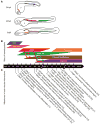Host-microbe interactions in the developing zebrafish
- PMID: 20153622
- PMCID: PMC3030977
- DOI: 10.1016/j.coi.2010.01.006
Host-microbe interactions in the developing zebrafish
Abstract
The amenability of the zebrafish to in vivo imaging and genetic analysis has fueled expanded use of this vertebrate model to investigate the molecular and cellular foundations of host-microbe relationships. Study of microbial encounters in zebrafish hosts has concentrated on developing embryonic and larval stages, when the advantages of the zebrafish model are maximized. A comprehensive understanding of these host-microbe interactions requires appreciation of the developmental context into which a microbe is introduced, as well as the effects of that microbial challenge on host ontogeny. In this review, we discuss how in vivo imaging and genetic analysis in zebrafish has advanced our knowledge of host-microbe interactions in the context of a developing vertebrate host. We focus on recent insights into immune cell ontogeny and function, commensal microbial relationships in the intestine, and microbial pathogenesis in zebrafish hosts.
Copyright 2010 Elsevier Ltd. All rights reserved.
Figures

Similar articles
-
Infection of zebrafish embryos with intracellular bacterial pathogens.J Vis Exp. 2012 Mar 15;(61):3781. doi: 10.3791/3781. J Vis Exp. 2012. PMID: 22453760 Free PMC article.
-
Zebrafish as a model organism to study host-pathogen interactions.Methods. 2013 Aug 15;62(3):241-5. doi: 10.1016/j.ymeth.2013.04.012. Epub 2013 Apr 22. Methods. 2013. PMID: 23619567
-
Study of host-microbe interactions in zebrafish.Methods Cell Biol. 2011;105:87-116. doi: 10.1016/B978-0-12-381320-6.00004-7. Methods Cell Biol. 2011. PMID: 21951527 Free PMC article.
-
Real-time imaging and genetic dissection of host-microbe interactions in zebrafish.Cell Microbiol. 2014 Jan;16(1):39-49. doi: 10.1111/cmi.12236. Epub 2013 Nov 19. Cell Microbiol. 2014. PMID: 24188444 Review.
-
Modeling Infectious Diseases in the Context of a Developing Immune System.Curr Top Dev Biol. 2017;124:277-329. doi: 10.1016/bs.ctdb.2016.10.006. Epub 2016 Dec 19. Curr Top Dev Biol. 2017. PMID: 28335862 Review.
Cited by
-
Nanoscale imaging of caveolin-1 membrane domains in vivo.PLoS One. 2015 Feb 3;10(2):e0117225. doi: 10.1371/journal.pone.0117225. eCollection 2015. PLoS One. 2015. PMID: 25646724 Free PMC article.
-
Transgenerational epigenetic inheritance: from phenomena to molecular mechanisms.Curr Opin Neurobiol. 2019 Dec;59:189-206. doi: 10.1016/j.conb.2019.09.012. Epub 2019 Oct 18. Curr Opin Neurobiol. 2019. PMID: 31634674 Free PMC article. Review.
-
Managing the Microbial Community of Marine Fish Larvae: A Holistic Perspective for Larviculture.Front Microbiol. 2018 Aug 27;9:1820. doi: 10.3389/fmicb.2018.01820. eCollection 2018. Front Microbiol. 2018. PMID: 30210457 Free PMC article. Review.
-
Population Genetic Divergence and Environment Influence the Gut Microbiome in Oregon Threespine Stickleback.Genes (Basel). 2019 Jun 26;10(7):484. doi: 10.3390/genes10070484. Genes (Basel). 2019. PMID: 31248008 Free PMC article.
-
Zebrafish (Danio rerio) behavioral phenotypes not underscored by different gut microbiota.bioRxiv [Preprint]. 2024 May 30:2024.05.29.596447. doi: 10.1101/2024.05.29.596447. bioRxiv. 2024. Update in: Ecol Evol. 2024 Aug 30;14(9):e70237. doi: 10.1002/ece3.70237. PMID: 38853862 Free PMC article. Updated. Preprint.
References
-
- Grunwald D, Eisen J. Headwaters of the zebrafish -- emergence of a new model vertebrate. Nat Rev Genet. 2002;3:717–724. - PubMed
-
- Lieschke GJ, Currie PD. Animal models of human disease: zebrafish swim into view. Nat Rev Genet. 2007;8:353–367. - PubMed
-
- Meeker N, Trede N. Immunology and zebrafish: spawning new models of human disease. Dev Comp Immunol. 2008;32:745–757. - PubMed
-
- Sullivan C, Kim CH. Zebrafish as a model for infectious disease and immune function. Fish Shellfish Immunol. 2008;25:341–350. - PubMed
-
- Hall CJ, Flores MV, C KE, Crosier PS. Live imaging early immune cell ontogeny and function in zebrafish Danio rerio. Journal of Fish Biology. 2008:1833–1871.
Publication types
MeSH terms
Grants and funding
LinkOut - more resources
Full Text Sources
Other Literature Sources

